|
 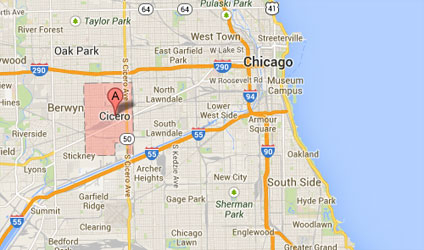 This suburb in Illinois immediately west of Chicago is well known for the gangsters that prowled its streets. Read the stories and click on the pictures to get a historical perspective of those criminals.
Please be advised that the gangsters here have created a great deal of carnage and that imagery is available below. Some pictures may be considered shocking, even though they have all been made avaiable to the public by news sources over the years.
|
by Mark Karadimos
| |
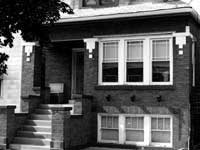
4850 West 28th Street
Cicero, IL
(2013) |
This is the once home of Captain Martin Wojciechowski. He became acting Police Chief in Cicero over two different terms, once when Joseph Horejs was removed from office for not fighting hard enough against crime in the town.
He and Town President Dr. Thomas Kallal agreed that a gambling syndicate is "flouting the law in our face" and it was reported in 1918 December 8th. |
|
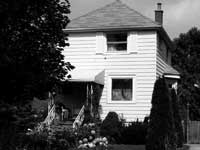
2641 South 60th Court
Cicero, IL
(2013) |
This is the once home of Lieutenant Nicholas Mongrieg (1878-1936). He was new to the Chicago Police Force in 1905 and was a lifelong resident of Cicero.
Reports confirm he opposed police corruption and the Capone gang. |
|
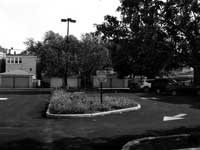
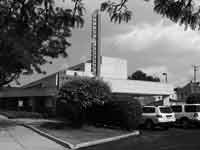 |
This parking lot used to be the home of two noteworthy hotels, one being The Hawthorne Hotel, which would have rested to the left. The other, which would have been to the right, was The Alton Hotel.
The Hawthorne Hotel, later called the Western Hotel, was the location where Al Capone operated his business. Al Capone made money: 1) by being ruthless, 2) via prostitution, and 3) via alcohol sales, even though Prohibition made the sale of alcohol a crime. His men often threatened businesses to sell his beer. If business owners did not comply, his men would destroy their establishments. Capone would offer to clean up the mess, afterward, when the business owners were unable to get money to fix up the businesses themselves, thereby placing owners in locked servitude with Capone.
In April of 1929, two men were found dead in a car, placed in back of the Hawthorne Hotel. They were determined to be two gangsters, William Clifford and Mike Reilly. Trailing the history of these gangsters, it was revealed they had shot a police officer, Albert Hoder, in the course of committing a murder. Officer Hoder identified them at the time of the shooting but refused to point them out at the day of the trial for the crime. The two criminals were acquitted. Yet, karma came around in the long run even though gangsters must have gotten to Hoder and/or his family.
The Alton Hotel was said to have been frequented by Frank Nitti, Jack McGurn, and Ralph Capone.
Like its neighbor hotel, The Alton Hotel was also plagued with trouble from gangsters. On 1926 September 21st, a cavalcade of eight motorcars opened fire on the Alton Hotel and the Hawthorne Hotel, injuring at least two people. Al "Scarface" Capone, who was dining at the Hawthorne Hotel, immediately exited through a back door.
Back in the 1980s in the mid-afternoon, a young man accidentally honked his horn as his car was parked outside the Alton Hotel. A young woman came outside of the hotel, approached the young man, and asked what he needed. He waved her off and explained it was an accident. Some time later it dawned on the man that the woman was indeed a prostitute.
[The third photo is from Restaurant-ing Through History. The fifth photo of this series was obtained from My Capone Museum.] |
|
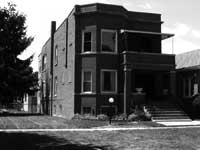
7244 South Prairie Avenue Chicago, IL (2013) 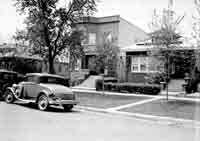
|
Al Capone (1899 - 1947) began life in Brooklyn, NY and started crime there within The Five Points Gang. He became a bouncer for a Frank Yale's Harvard Inn, which was a speakeasy. After insulting Lena Galluccio, her brother Frank attacked Capone and cut him on the left-side of his face three times, hence the name "Scarface." Nevertheless, Capone was able to gain the grace of John Torrio as a thug. Either Capone or Yale probably killed Torrio's boss, Jim Colisomo, which paved the way for Torrio's rule.
Capone was sent to Chicago and operated Torrio's Four Deuces at 2222 South Wabash Avenue. Profits were said to be $100,000 per month. Nevertheless, Capone moved operations to Cicero, probably to take advantage of expanding markets outside of the city. His brothers Frank and Ralph helped him manage operations in Cicero. They took control of brothels, gambling clubs and racetracks by bribing officials (like Cicero President Klenha), threatening/kidnapping election workers, and killing the opposition. The Capones were able to move beer to speakeasies and began bootlegging whiskey from New York with the help of Frank Yale in New York and Louis Campagna, Claude Maddox, Frank Nitti, Antonio Lombardo, Jake Guzik, and Willie Heeney in Cicero/Chicago. Joseph Aiuppa, triggerman and gambling peddler, as well as wheelman, Sam Giancana, helped Al Capone, too.
Gangsters became very violent, with hundreds of gangster slayings sickening the public. Feuds between rival gangs, like the Moran gang in the north with the Capone gang in the south were legendary. Even Torrio wasn't immune and lived through a failed assassination attempt. His retirement to New York gained Capone even more power.
However, two notable events marked huge mistakes by the Capone gang: 1) The death of Assistant State's Attorney William H. McSwiggin and 2) The St. Valentine's Massacre. These two events made people extremely upset, causing politicians and prosecutors to respond to public pressure.
Prosecutors were unable to pin anything on him, except when he ventured to Philadelphia. They nabbed him for possession of a concealed gun. A strange, speedy trial landed him a year in jail beginning on May 17th, 1929. Next, he was prosecuted for income tax evasion. He was convicted and given an astonishing 11-year sentence on October 18th, 1931 and entered into the U.S. Penitentiary in Atlanta. he was eventually moved to Alcatraz, where he lost all of the privileges he bought in the Penitentiary.
He only served 7½ years of the sentence due to illness. He fell ill from paresis derived from syphilis, which attacked his brain. It made him child-like and confused. His health slowly declines until he died on January 25th, 1947 in Miami.
[The second picture was taken from Loyola University: Chicago's Past.]
|
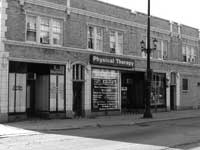
2208 South Austin Boulevard
Cicero, IL
(2013) |
The girlfriend of James "Fur" Sammons, Pearl Hruby, owned a beauty shop. On 1926 April 23rd, 100+ machine gun bullets were shot into her business and Sammons' car, which sat out front.
Upon examining the tiles outside this empty business, some of them had circular divets, but it is unknown if they are the result of the original incident.
In regard to James Sammons, he started his criminal career as a rapist at the age of 16 of an 11-year-old in December of 1899. He continued a path of destruction with murder, escaping a prison, robbery, carrying a loaded weapon, and bribing an official. On November 17th, 1948, Sammons openly wept in court when he was denied parole. He wept probably like the little girl he beat, raped, and stabbed, which is fitting karma for this psychopath. He died, alone and blind in a boarding house (Englewood Arms Hotel 824 W. 62nd Street) on May 20, 1960.
Had those bullets that were fired on April 23rd, 1926 found their mark, namely James Sammons, many lives would have been spared misery at his pathetic, lawless hands. It would have been one of those few instances that the actions of one criminal against another would have helped society. |
|
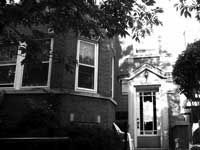
1117 South Austin Boulevard Cicero, IL (2013) 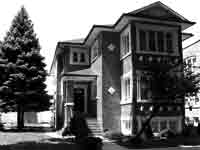
|
Scarface's brother, Ralph Capone (1894 – 1974), lived a few blocks north of the Capone Party House circa 1925. Ralph was said to have operated a nightclub in Cicero, called the Cotton Club. He also ran the beer operations for his brother.
Ralph got the name "Bottles" for his work with non-alcoholic beverages.
Karma eventually grabbed Ralph Capone. He was sentenced to three years and a $10,000 fine for an undivulged $4000 deposit to his bank account. The IRS nabbed both Capone brothers for income tax fraud, where other crime laws failed.
Three years after Ralph's death in 1977, his widow, Madeline, married his best friend and long-time business associate Serefeno Morichetti. That was warm-hearted of Morichetti to move in on Ralph's wife. |
|
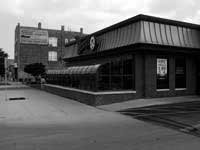
5141 West 22nd Street
Cicero, IL
(2013) |
Al Capone clearly had no regard for life, property, or rule of law. His escapades across Chicago and Cicero gained him a great deal of attention and reporters began writing a lot about him. They would report shootings, slayings, and a lack of regard for laws, like the Prohibition of alcohol. When enough stories are written about Capone's evil deeds, he started to feel pressure.
Allegedly, Ralph Capone beat a newspaper editor-writer, Robert St. John, to a pulp for writing about his brother Al in the Cicero Tribune. This happened on 1925 April 6th in front of 5141 West 22nd street, the now home of a Wendy's Fast Food Restaurant. |
|
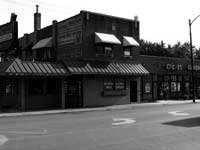
5613 West Roosevelt Road Cicero, IL (2013) 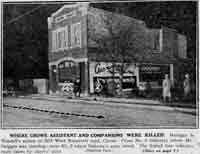
|
On the night of 1926 April 27th at 8:40 in the evening, an event occurred at this address that rocked the world of organized crime. Cook County Assistant State's Attorney William H. McSwiggin was gunned down by a machine gun outside of a saloon. He was accompanied by two companions, named Doherty and Duffy, who were known gangsters.
While people were content to see gangsters killing gangsters, they grew very discontent over the murder of this agent of the state. It may be also the case that his gangster associates caused another level of interest, which gave it and the hundreds of other gangster killings fodder for journalists everywhere. This case that received national attention placed a considerable amount of pressure on Al Capone, as it was thought he had a hand in the slaying. When Capone was interviewed by a reporter in advance of formal investigations, Capone said this:
Of course I didn't kill him. Why should I? I liked the kid. Only one day before he got killed he was up to my place and when he went home I gave him a bottle of 'scotch' for his old man. I paid Swiggin and I paid him plenty, and I got what I was paying for.
This flagrant display for a lack of concern for the law must have motivated investigators and prosecutors to dig deep into Alphonso Capone's activities.
The location of the crime happened outside the Pony Inn. The inn is long gone and has been replaced by a failed business.
[The second photo was taken from Homicides in Chicago, 1926: Capone vs. McSwiggin. The third photo was taken from Loyola University: Chicago's Past.] |
|

|
Frank "The Enforcer" Nitti (1886 - 1943) was an extremely close associate of Al Capone and may have supplied as many as 20,000 speakeasies and stills/collections within several towns for "Scarface." He handled the logistics, most likely also the hit on "Hymie" Weiss in 1926, and used labot unions to extort money from Hollywood film studios.
What is most interesting about Nitti was his demise. While The Capone's were eventually nabbed for income tax evasion, many other gangsters were caught for direct criminal behavior. Others still were killed by other gangsters in rival beer wars.
However, Nitti denied prosecutors from a trial. Obviously sensing looming indicators that he too would soon be pursued successfully by authorities, Nitti took the coward's way out. In 1943 March 19th, he shot himself in the head while he walked near train tracks north of his Riverside home. It took him three bullets to get the job done. The event was witnessed by railmen who thought Nitti may have been shooting at them. His body eventually landed alongside a fence with his head slumped against it.
[The death photo was taken from My Al Capone Museum.]
|
|
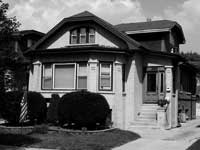
2927 Maple
Berwyn, IL
(2013) |
This is the once home of Louis "Little New York" Campagna (1900 - 1955), a former bodyguard for Al Capone. Al Capone placed a $50,000 bounty on bootlegger Joe Aiello, Campagna stormed a police district that held Aiello, which got him placed in jail. Three years later, Aiello was killed.
Court testimony in another gangster trial revealed the possibility that Campagna was chosen to kill the late Mayor Anton J. Cermak. Nevertheless, Campagna was involved with labor racketeering and organized gambling. After Anthony Accardo allegedly bribed a district attorney, Campagna got an early release from an extortion sentence. He then worked for Sam Giancana in the late 40s.
Campagna's death was less than stellar. He dropped dead of a heart attack after reeling in a fish. The Catholic Church rightfully refused to provide Campagna a church funeral.
|
|
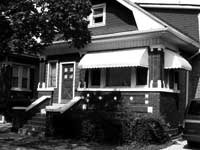
2111 South Austin Boulevard
Cicero, IL
(2013) |
Antonio Lombardo (1892 - 1928) was well-known for his ambitious efforts in organized crime within a liquor niche. He went in to business with Aiello and Ferrera, but it quickly ended.
After a series of assassinations of Sicilian organized crime figures in Chicago, Antonio Lombardo eventually became leader of the Unione Sicilianan, which came with it a great deal of influence and power. However, he and Aiello had a falling out. Lombardo sided with southsiders, Torrio-Capone, and Aiello sided with the northsiders: O’Banion’s followers “Hymie” Weiss, George “Bugs” Moran, and Vincent “Schemer” Drucci.
Intense competition from liquor sales and an alleged Aiello poison attempt on Lombardo and Capone, left Capone with little alternative. Capone may have given Campagna a bounty on Aiello's life.
Lombardo's days were numbered. He came to an end on 1928 September 8th at 4:30 in the afternoon and it was believed to have been the result of efforts by Aiello who aspired to be leader of the Unione Sicilianan. He was assassinated by gangsters who exited a Greek Restaurant. Soon thereafter, Aiello was killed, as well.
|
|
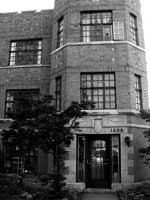
1600 South Austin Boulevard
Cicero, IL
(2013) |
Al Capone used this property as a "Party House." It was conveniently located near his base of operations in Cicero and it was far enough from his home on Prairie Street to keep his family isolated from his activities. The building supposedly had reinforced doors and a large back fence.
|
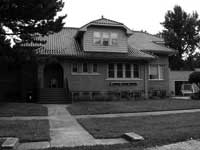
3536 South Harlem
Riverside, IL
(2013) |
Claude Maddox (1897 - 1958) helped Al Capone deal with gambling, encroaching on union involvement, protecting political interests by protecting against witnesses who would testify against Frank Nitti, and more. He was the sole northside organization that worked with Al Capone.
It is surmised that Al Capone's wish to go to war with northsiders required the assistance of Maddox and Tony Accardo. Capone used these men when masterminding the Valentine's Day Massacre, as some people have theorized. |
|
|
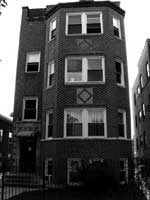
1538 South Austin Boulevard
Cicero, IL
(2013) |
Willie Heeney (1887 - 1951) worked with Al Capone, along with Claude Maddox and Louis Campagna. He also formed a business partnership with Joseph Korngold and Louis Campagna for two gambling clubs.
Story has it that Heeney and an associate entered a home posing as Prohibition agents. They confiscated $15,000 worth of whiskey and left, making off with quite a prize.
Heeney's death was fitting. He was a cancer on society and cancer is exactly what killed him. |
|
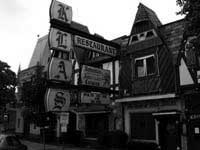
5734 West 22nd Street
Cicero, IL
(2013) |
Klas Restaurant is said to have had gangster visitors in its past. Even gangsters like good food. This restaurant has great tasting Bohemian food and an upstairs, wooden room that is truly remarkable. |
|
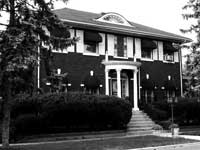
1873 South Austin Boulevard
Cicero, IL
(2013) |
Joseph Z. Klenha moved to Cicero in 1914 and was elected to its town board in 1917. He became Cicero President in 1924. Unfortunately, Klenha had choices to make as president, but he made bad ones.
Sources indicate that Klenha was bought by Al Capone. When Klenha was concerned that a certain election was going to be close, Al Capone told him not to worry. Three Capone men, one possibly being Al himself, went to a Cicero precinct and displayed their arms to send a message to voters. Legend also has it that Al Capone struck Klenha on the steps of city hall while police officers looked on and did nothing.
In 1932, Klenha was defeated by Joseph G. Cerny because Ciceronians were frustrated by the lack of progress dealing with organized crime. |
|
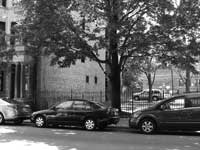
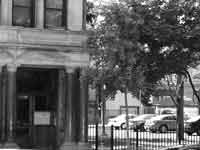
|
This event marked the largest and most important slaughter of gangsters in gangster history. Seven victims were reported to have died that day, called the St. Valentine's Day Massacre on February 14, 1929.
- Peter Gusenberg: a frontline enforcer for the Moran organization.
- Frank Gusenberg: the brother of Peter Gusenberg and also an enforcer. Frank was still alive when police first arrived on the scene, despite reportedly having fourteen bullets in his body. When questioned by the police about the shooting, his only response was "Nobody shot me." He died three hours later.
- Albert Kachellek (alias "James Clark"): Moran's second-in-command.
- Adam Heyer: the bookkeeper and business manager of the Moran gang.
- Reinhardt Schwimmer: an optician who had abandoned his practice to gamble on horse racing (unsuccessfully) and associate with the Moran gang. Although Schwimmer called himself an "optometrist" he was actually an optician (an eyeglass fitter) and had no medical training.
- Albert Weinshank: who managed several cleaning and dyeing operations for Moran. His resemblance to Moran, including the clothes he was wearing, is what allegedly set the massacre in motion before Moran actually arrived.
- John Mayan: occasional car mechanic for the Moran gang, though not a gang member himself. May had two earlier arrests (no convictions) but was attempting to work legally. However, his desperate need of cash, with a wife and seven children, caused May to accept jobs with the Moran gang as a mechanic.
The summary of the event is simple. Strong rivalries between northside and southside beer running caused a huge rift among organized crime figures. Moran in the north and Capone in the south had only a temporary reprieve from conflict because big money was at stake with literally tens of thousands of speakeasies and bars to supply with alcohol. The possibility of gaining more points of distribution -- greed -- forced bosses to order hits on the opposition. Hence the hit.
The men who machine gunned members of the Moran gang were dressed as police officers. Were they actual crooked police officers? Whether they were or were not police officers, these uniforms were acquired from a criminal underworld that had connections. These connections were not limited to police agencies, aldermen in Chicago, and political leaders in Chicago and elsewhere. One more thing: whether or not Capone ordered the hit, the event served as a great motivator to prosecute Capone.
Even Bugs Moran spoke to the press and implicated "...the Al Capone gang." He went on to say, "If there were any policemen in the shooting, they were Cicero policemen."
[The third and fourth photos for this section were obtained from Jonathan Eig's May 2010 article in Chicago Magazine: The St. Valentine’s Day Massacre — Excerpt from “Get Capone.”. The last photo is from The St. Valentine’s Day Massacre — Excerpt from “Get Capone.”]
|
|
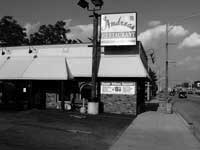 |
Andreas Restaurant used to be called, The Armory Lounge. Many gangsters used to frequent this lounge, including Sam Giancana. Frank Sinatra was said to cavort with Sam Giancana, via Kitty Kelley's biography of Sinatra, at the Armory Lounge and other lounges across the region. This gave credence to the claims "Old Blue Eyes" may have owed his career to the dirty hands of organized crime figures.
[The last photo for this section was obtained from Gangland Chicago History: Crime Scene Photos.]
|
|
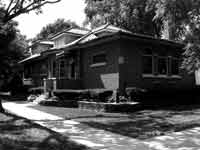
|
Sam Giancana (1908 - 1975) was said to have started as a driver for the Capone gang. He later went from driver to hitman and was investigated but never tried for three murders. He also went on to dominate gambling operations within Black neighborhoods. He succeeded Anthony Accardo as leader of the Chicago Outfit. He then built up several layers of operations, like gambling, prostitution, narcotics trafficking, and other illegal industries. We know these things about the Chicago Mafia because wire-taps were placed within The Armory Lounge in '59.
Giancana's life is forever coupled with the Kennedys.
Facts: 1) Giancana dated Judith Campbell Exner and she was also involved in a relationship with President John F. Kennedy. 2) Robert Kennedy convinced J Edgar Hoover to place Giancana's Oak Park home on 24-hour surviellance. 3) Giancana had gambling interests in Cuba. He stood to gain a lot if Castro was killed. So, Giancana was sought after in a plot to kill Castro.
Speculation: a) Giancana helped get JFK elected by ballot manipulation in Cook County. b) The Kennedys wanted Castro dead, too, due to the Bay of Pigs scandal and Exner communicated plans to kill Castro bewteen JFK and Giancana. c) Giancana got JFK elected, possibly due to bootlegging ties with Joe Kennedy (father of John and Robert); so, he became upset when Robert Kennedy sought to prosecute Giancana. Consequently, Giancana had a hand in JFK and Robert's death.
Giancana died in a basement kitchen of his Oak Park home around 11 pm on June 19th, 1975. It was thought he knew the killer(s) because no forced entry was detected. He was shot six times in the head with 22-caliber rounds, one of which was in the mouth. The mob may have been sending a message that Giancana was talking too much. Before his death, he was due to speak to a committee concerning a CIA plot to kill Fidel Castro in Cuba. Years later, it was revealed his predecessor, Joseph Aiuppa, personally approved the killing. According to former Willow Springs, IL, Police Chief Michael Corbitt, statements by Outfit Capo Sal Bastone implicated Anthony Spilotro in the murder.
[The last photo for this section was obtained from Gangland Chicago History: Crime Scene Photos.]
|
|
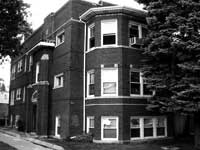
1836 South 58th Avenue
Cicero, IL
(2013) |
Joseph "Doves" Aiuppa (1907 - 1997) owned several Cicero homes over the years, but he called this location home for several years. Aiello has a long past, either due to prosecutorial embellishment or not, it has been said Aiuppa was connected to the John Dillinger and Alvin Karpis gangs in the early 1930s. However, he was a goon for Al Capone. He was also involved with bar ownership (Frolics & The Turf), racketeering, and manufacturing of crooked gambling equipment. He was in control of several lounges and strip joints in Cicero, too, where prostitution occurred.
Aiuppa was connected with several worker unions: 1) the American Guild of Variety Artists, 2) an official of Local 782 of the Teamsters Union of Maywood, 3) ties to the Hotel and Restaurant Employees Union, and 4) ties to the Hotel & Restaurant Employees and Bartenders International Union of Local 450 Cicero.
Aiuppa's criminal involvement crossed paths with John F. Kennedy's brother, Robert, who was a committee counselman for a Senate Rackets Investigating Committee. Robert Kennedy suggesting adding amendments to labor law to take care of the Aiuppas in the union field.
Aiuppa most likely ordered Anthony Spilotro to kill former boss, Sam Giancana, which occurred in the basement of Giancana's Oak Park home.
Aiuppa was convicted of a 28-year sentence for skimming money from a Las Vegas casino, but he served only ten years of his sentence. He died of natural causes one year after his release as a frail, old man.
|
|
|
|
|

